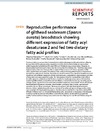Please use this identifier to cite or link to this item:
https://accedacris.ulpgc.es/jspui/handle/10553/74643
| Title: | Reproductive performance of gilthead seabream (Sparus aurata) broodstock showing different expression of fatty acyl desaturase 2 and fed two dietary fatty acid profiles | Authors: | Shajahan, Ferosekhan Xu, Hanlin Turkmen, Serhat Gómez, Ana Afonso, Juan Manuel Fontanillas, Ramon Rosenlund, Grethe Kaushik, Sadasivam Izquierdo, Marisol |
UNESCO Clasification: | 310502 Piscicultura | Keywords: | Sparus aurata | Issue Date: | 2020 | Project: | Consumer driven Production: Integrating Innovative Approaches for Competitive and Sustainable Performance across the Mediterranean Aquaculture Value Chain | Journal: | Scientific Reports | Abstract: | Previous studies have shown that it is possible to nutritionally program gilthead seabream offspring through fish oil (FO) replacement by vegetable oils (VO) in the broodstock diet, to improve their ability to grow fast when fed low fish meal (FM) and FO diets during grow-out phase. However, in those studies broodstock performance was reduced by the VO contained diet. Therefore, the present study aimed to determine if it is possible to replace FO by a mixture of FO and rapeseed oil (RO) with a specific fatty acid profile in broodstock diets, without altering gilthead seabream broodstock reproductive performance. Besides, the study also aimed to evaluate the reproductive performance of broodstock with different expression of fatty acid desaturase 2 gene (fads2) a key enzyme in synthesis of long chain polyunsaturated fatty acids. For that purpose, broodfish having either a high (HD) or low (LD) expression of fads2 were fed for three months during the spawning season with two diets containing different fatty acid profiles and their effects on reproductive hormones, fecundity, sperm and egg quality, egg biochemical composition and fads2 expression were studied. The results showed that blood fads2 expression in females, which tended to be higher than in males, was positively related to plasma 17β-estradiol levels. Moreover, broodstock with high blood fads2 expression showed a better reproductive performance, in terms of fecundity and sperm and egg quality, which was correlated with female fads2 expression. Our data also showed that it is feasible to reduce ARA, EPA and DHA down to 0.43, 6.6 and 8.4% total fatty acids, respectively, in broodstock diets designed to induce nutritional programming effects in the offspring without adverse effects on spawning quality. Further studies are being conducted to test the offspring with low FM and FO diets along life span. | URI: | https://accedacris.ulpgc.es/handle/10553/74643 | ISSN: | 2045-2322 | DOI: | 10.1038/s41598-020-72166-5 | Source: | Scientific Reports [EISSN 2045-2322], v. 10 (1), 15547, (Diciembre 2020) |
| Appears in Collections: | Artículos |
SCOPUSTM
Citations
18
checked on Jun 8, 2025
WEB OF SCIENCETM
Citations
15
checked on Jun 8, 2025
Page view(s)
318
checked on Jul 12, 2025
Download(s)
200
checked on Jul 12, 2025
Google ScholarTM
Check
Altmetric
Share
Export metadata
Items in accedaCRIS are protected by copyright, with all rights reserved, unless otherwise indicated.
